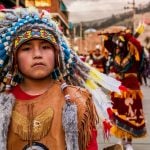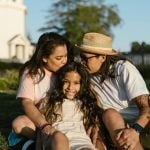Southern California Indian Clothing
With the relatively warm climate of Southern California, the Native Americans in area did not need clothing for warmth and nudity was common. Frequently, children wore no clothing until they were about ten years old. Women often wore a short skirt made of plant fiber and went naked above the waist.
With regard to footwear, people often went barefoot. They would sometimes wear sandals made from yucca or sandals with a tough hide sole.
With regard to the Gabrielino, Lowell John Bean and Charles Smith, in their entry in the Handbook of North American Indians, report:
“Men and children usually went naked, while women wore aprons of either deerskin or the inner bark of willow or cottonwood trees.”
Writing about the Luiseño in 1924, anthropologist A. L. Kroeber reports:
“Clothing was of the common type—nothing for men, a back and front apron for women, with yucca fiber sandals and caps on occasion. The cap was worn chiefly with loads.”
Writing about Chumash clothing in her book Encyclopedia of American Indian Costume, Josephine Paterek reports:
“Men wore a wraparound buckskin kilt, when they wore anything.”
Josephine Paterek also writes:
“Women wore the two-pierce skirt, commonly of tule or sea grass, or sometimes the shredded bark of willow or sycamore trees. Small globules of asphaltum were attached to the ends of the fibers to weight the skirt down against the wind.”
One of the displays in the Riverside Metropolitan Museum in Riverside, California, looks at Southern California Indian clothing. According to the display:
“Clothing in Southern California was made from plants and animals the people gathered and hunted. Women wore skirts made of willow bark and milkweed fiber. Shoes made of yucca were worn to travel long distances. Shells were worn for decoration. Baskets were made to wear as hats. In the winter months, rabbit fur blankets were used to keep people warm.”
 Shown above is a Tongva woman’s basketry hat made before 1890. It is woven from sumac and juncus.
Shown above is a Tongva woman’s basketry hat made before 1890. It is woven from sumac and juncus.  Shown above is a 1924 photograph by Edward Curtis.
Shown above is a 1924 photograph by Edward Curtis.  Shown above is a Kumeyaay woman’s back skirt made of the inner bark of dogbane or red willow. This skirt was made prior to 1911.
Shown above is a Kumeyaay woman’s back skirt made of the inner bark of dogbane or red willow. This skirt was made prior to 1911.  Shown above is a pair of Kumeyaay yucca sandals made prior to 1911 and a Kumeyaay cordage skirt made prior to 1911.
Shown above is a pair of Kumeyaay yucca sandals made prior to 1911 and a Kumeyaay cordage skirt made prior to 1911.




